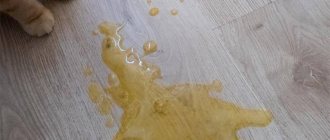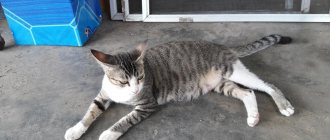A sudden deterioration in the health of a beloved pet is a serious cause for concern. Particularly dangerous is a change in the color of discharge: urine, feces and vomit. If your dog is vomiting yellow foam, ask your veterinarian what to do to normalize the condition. Vomiting is only a symptom, not an independent disease. To find out the true cause, the animal will have to undergo diagnostics at a veterinary clinic.
Why does vomit turn yellow?
The walls of the stomach are covered with mucus, which protects against the aggressive effects of gastric juice. The air swallowed by the dog penetrates inside and enters into a chemical reaction with the mucus. The result is a clear or pale yellow foam. Its light color is given by gastric juice, and the more intense shade of yellow is due to mixing with bile. It is produced by hepatocytes - liver cells. Normally, this fluid accumulates in the gallbladder and small intestine, but under the influence of certain physiological and pathological reasons it penetrates into the stomach.
What to do if your dog is vomiting foam
To resolve the above symptoms, it is important to identify the problem. There is no need to treat vomiting.
So, what should you do if your dog vomits white foam? The answer is obvious - look for the reason for this. Of course, a visit to the veterinary clinic will help here, where your pet will have a blood test and an abdominal x-ray. Only based on the results of the examination and tests can the source of this symptom be determined.
But it also happens that the dog vomits, but it is not possible to get to the veterinarian quickly. Then you need to adhere to certain rules. First of all, you should rid your pet’s body of suspected poisoners or irritants. In this case, he is not fed or sung for a day, but is only allowed to lick ice cubes.
When this helps and the vomiting stops bothering you, you can feed a small amount of chicken broth. Next, you can offer pureed white meat chicken or turkey breast. At the same time, you should feed your pet in small doses 4-6 times a day, adding fresh herbs and brown rice to the food to strengthen the stomach if diarrhea is also bothering you. You can start giving your usual foods from the third day.
Suitable medications include No-shpa, Papaverine, Smecta, Cerucal, Omez. They relieve spasms in the stomach and intestines. Otherwise, medications can only be prescribed by a specialist. Self-medication is unacceptable, it can cause harm.
What should you do if your dog vomits yellow foam? As noted above, it is also good to keep her on a diet, paying attention to her behavior. If the vomiting of bile stops and the condition improves, there is no need to worry. Often a well-developed diet and diet can solve the problem.
But when a dog vomits several times a day, it should be taken to the veterinarian so that competent measures can be taken in time. As you can see, external eruptions from a dog’s mouth do not always indicate a dangerous condition of the animal. Often the reason for this symptom lies in inattention to the pet.
And how can one not remember the wise words about responsibility for those whom they took in? So if you decide to get a dog, give it the time it deserves. Remember that his feeding should be varied and complete, and walks should be constant, at least 2-3 times a day. To this should also be added vaccinations on time and various preventive measures. Only this approach can ensure the health of your dog.
Therefore, if you decide to get a dog, think carefully about whether you are capable of such sacrifices on your part. After all, your animal may be sick, and its recovery will depend only on you.
Currently reading:
- The American Cocker Spaniel is an adroit hunter and loyal friend.
- Recommendations for obedience of a dog if it growls
- Tips for proper dog burial
- Is it worth it or not to include natural food in your dog’s diet?
Possible causes of discomfort
If you notice vomiting of bile in your dog, observe the frequency of vomiting. With one-time nausea and the absence of accompanying symptoms, the likelihood of a physiological cause is high. If the attacks do not stop, and the animal’s condition rapidly worsens, go to the veterinarian.
Dangerous (if repeated vomiting)
If your pet not only feels sick, but also has diarrhea and is bothered by a fever, then the deterioration of his condition is due to internal problems. Repeated attacks lead to severe dehydration, which is especially dangerous for puppies.
Possible pathologies include:
- Poisoning
. Acute intoxication can be caused by poison, spoiled food, or ordinary foods from the human table included in the prohibited list (confectionery, smoked meats, pickles).
- Helminthiasis
. Along with the vomit, some of the helminths come out, so large individuals can be detected without laboratory analysis.
- Infectious and blood parasitic diseases
. Your pet may be infected with infectious hepatitis, parvovirus enteritis, leptospirosis or piroplasmosis. In severe cases of the disease, blood clots come out along with yellow mucus and foam.
- Malignant neoplasms
. The growth of a tumor in the gall bladder or liver is accompanied by a decrease in activity and rapid weight loss while maintaining appetite.
- Stomach and intestinal ulcers
. The pet vomits bile mixed with undigested pieces of food, and is also tormented by foul-smelling belching.
- Liver pathologies
(liver failure, cholecystitis)
and kidneys
(renal failure, hepatitis). There is a refusal to feed, frequent belching and bloating. Jaundice, yellow-green diarrhea, or an ammonia-like odor from the mouth may occur. - Stomach diseases
(gastroenteritis, gastritis)
and pancreas
(pancreatitis). There is increased salivation, abdominal pain, weight loss, dullness and hair loss. - Intestinal obstruction
. It is caused by stuck foreign objects, an enlarged uterus, or the insertion of one part of the intestine into another (intussusception). Due to impaired blood circulation, tissue necrosis (death) is possible. Nausea occurs along with an increase in body temperature.
Also, the release of bile can be explained by prolonged drug treatment. Only a veterinarian can determine the exact cause, so do not delay your visit to the clinic and do not try to solve the problem yourself.
Non-hazardous (with single vomiting)
If your four-legged pet vomits once, and within a day he looks completely healthy, don’t worry. This may be explained by:
- Foreign object in the stomach
. Swallowed hairballs, stones, pieces of toys or bones do not always cause intestinal obstruction. To remove them, the dog actively chews grass while walking. If you notice this behavior, do not scold your pet and allow the stuck objects to come out naturally.
- Experienced stress
. Traveling on public transport, moving, or meeting a new family member are exciting events that can cause a slight stomach upset.
- Overheating
. Avoid staying in a closed car for too long or walking too long in the hot sun. If there is severe overheating, the animal may experience heatstroke, accompanied by a strong increase in temperature and muscle cramps. Hairless breeds are at risk.
- Hunger
. If you feed the animal too rarely, its gastric juice will accumulate in larger quantities. Try to shorten the interval between feedings.
- Food intolerance
. Due to artificial additives, many products cause a mild form of poisoning in animals, preventing normal digestion. What distinguishes intolerance from allergies is the longer onset of the reaction and the lack of response from the immune system.
- Overeating
. When consuming food granules that are too small, the dog feels full late. The body has to get rid of excess on its own. With low water intake, the feed will be dissolved using the liquid contained in the intestines. This can lead to serious complications, so try to ensure adequate water intake when dry feeding.
To normalize the animal’s condition, try changing the food or diversifying the diet with fermented milk products. If there is no improvement and your health worsens, sign up for an examination at the veterinary clinic.
Further treatment
It is important for the owner to report all signs of pathology. It is necessary to remember the presence of gastrointestinal diseases, eaten junk food, such as chicken bones. It should be noted when the symptom began and what may have contributed to it. To simplify the diagnosis of the disease, you should notify your veterinarian of the following signs:
- Continuous vomiting of bile, which occurs in the morning and at night.
- Loss of appetite.
- Discomfort in the stomach, which causes the pet to growl and whine.
- Nausea. The dog periodically tenses up, looks at one point, and groans. Her movements indicate that she is about to vomit.
- Diarrhea. It indicates serious disruptions in the digestive processes.
- Exhaustion. Rapid weight loss, sunken eyes, pale mucous membranes, deterioration of coat.
You should also provide information about the consistency of the vomit, its quantity, and color. It is necessary to talk about changes in behavior, the frequency of symptoms, whether they existed before. These nuances can greatly facilitate diagnosis.
The doctor will thoroughly examine the dog. A urine and blood test will be required - this will help determine gastric ailments. Vomiting often indicates an infection, which can be easily detected using the diagnostic methods listed above. If the disease is not detected, an x-ray and ultrasound of the abdominal cavity are prescribed.
Before the x-ray, you need to give your pet barium pulp. It will help determine gastric obstruction, volvulus, and gastrointestinal atony. Gastroendoscopy is also sometimes recommended.
If the exact root cause is not found, symptomatic therapy should be started. A specialist can determine that a single attack does not indicate a serious illness and prescribe Lansoprazole. The dose of the drug is determined individually, but usually it is 30 mg of the drug 30 minutes before meals. But they pay attention to the weight of the dog. The product reduces the concentration of hydrochloric acid and reduces the risk of vomiting. The doctor will also recommend giving food at night so that your pet wakes up less hungry.
Sometimes a specialist prescribes medications with a choleretic effect, such as Odeston. These drugs are allowed to be taken only after an accurate diagnosis.
For hyperacid gastritis, medications are prescribed to reduce acidity. Medicines that relieve spasms of smooth muscles help. First, the pet may be recommended to drink activated carbon or Smecta. They minimize the damage that bile causes to the mucous membrane.
In case of chronic gastritis, along with medications, you will need to follow a diet, which includes the use of special foods. The owner must take into account the upcoming costs, since the cost of diets with a therapeutic effect will be more expensive than standard ones. For hepatitis, they give Allohol. If worms are detected, deworming with drugs is recommended.
Animals usually respond well to therapy. It is necessary to understand that the treatment will be long-term and it is not worth interrupting it abruptly. Only a doctor can determine how long the course lasts. Vomiting often occurs due to the fact that the animal is given a lot of food on an empty stomach. Therefore, experts do not recommend feeding service dogs once a day.
This is especially dangerous for animals that are heavily overloaded. If a fatty and nutritious meal is offered after a day's work when they are hungry, the release of bile can cause damage to the digestive organs and even death due to cholemia.
This also applies to severely malnourished animals. If the owner has adopted a thin dog, there is no need to immediately give huge portions. The best food for her will be broth. The physiology of the dog implies that with a prolonged absence of food in the stomach, atony may develop.
Associated symptoms
To recognize a pathological cause, note any signs that appear. You will need to see a doctor if your dog has not only yellow vomiting, but also other alarming symptoms:
- loss of appetite and refusal to drink water, leading to weight loss;
- frequent belching, pain and rumbling in the stomach;
- the appearance of diarrhea or constipation;
- change in the color of urine to bright orange and paleness of stool to a gray tint;
- blue or yellowing of mucous membranes;
- increased temperature, increased heart rate and shortness of breath;
- dulling and matting of fur;
- frequent licking and excessive salivation;
- sudden change in mood (drowsiness and apathy are replaced by excessive affection or aggression);
- difficulty moving.
One of the most dangerous signs is hematemesis, that is, the appearance of blood in the vomit. This negatively affects the immune system and can also lead to the death of the animal due to internal bleeding.
What to do
If your dog has only vomited yellow bile once, don't be discouraged. Monitor your dog for lethargy, diarrhea, loss of appetite, weakness, and other signs of illness. If your dog seems normal, monitor the amount of elimination. If vomiting persists, skip your dog's next food and continue to observe.
If vomiting continues, consult your veterinarian. This course of action is suitable for any type of vomiting. Therefore, do not be surprised if you find similar text in other articles on our website regarding vomiting in dogs, because the action plan is practically no different.
Bile consists of water, lecithin, cholesterol, bicarbonate ions, pigments and bile salts. Therefore, yellow vomit may mean that bile has entered the stomach. This usually occurs if the diet included foods rich in fat or a significant amount of grass.
How you can help at home
In the absence of new attacks and maintaining good health, it is enough to limit yourself to a starvation diet. Leave your pet without food for half a day, making sure to provide enough water. At the end of the fast, check your reaction to a sugar cube. If nausea does not return, continue feeding as usual.
In case of repeated attacks, it is better to entrust treatment to a veterinarian. Prior to examination, avoid feeding and replace water with ice cubes. Do not try to stop nausea with antiemetic drugs: they can blur the symptoms or worsen the patient's condition. To alleviate the condition, you can give your pet activated carbon or Enterosgel, which absorbs toxins.
If a visit to the clinic is not possible in the near future, try to prevent dehydration on your own. Prepare an isotonic solution by mixing water with salt and sugar, and feed it to the animal until you receive medical help. Intravenous Ringer's solution or 5% glucose solution are also suitable.
After removing a tick from your pet, drop everything and go for an examination, even if you are outside the city limits. If treatment is late, the dog’s chance of recovery is reduced to 5%.
How to help a dog
The animal's condition can be acute or chronic. Acute develops suddenly. If this is biliary vomiting syndrome or a manifestation of an existing disease, then it begins in the morning after the pet has had breakfast. The dog may vomit the food it has just eaten. If we are talking about poisoning and exposure to toxins, then vomiting with bile may begin a few minutes or hours after a walk. It all depends on how quickly the toxin spreads in the body.
To help your dog you need:
- Provide peace.
- Give an antiemetic that prevents dehydration and stops vomiting. This is Metoclopramide at a dosage of 0.1–0.5 mg/kg. You can also use Prochlorperazine, Domperidone.
- Be sure to organize rest of the pancreas and gastrointestinal tract by refusing food and, possibly, water for 24 hours. Modern treatment methods do not recommend fasting for a long time. Therefore, as soon as the pet is able to digest food, he should immediately be offered something soft, for example, boiled rice, potatoes or pasta. Digestion of these starchy foods makes digestion easier.
- In the future, do 3-4 feedings a day in fractional portions.
- Monitor the condition. And if your pet continues to vomit, intravenous fluid therapy may be needed. Therefore, at this stage you need to arrange with a doctor to examine the dog.
The chronic condition begins after the acute attack is relieved. In this case, treatment will be carried out, which will be prescribed by the doctor. It depends on the diagnosis.
Veterinarian visit and treatment
To make a diagnosis, you will need to take blood and urine tests, as well as undergo an ultrasound and x-ray. Depending on the results, the veterinarian may order other laboratory tests to identify the pathogen and where the problem is occurring.
Depending on the cause, the four-legged patient is prescribed the following treatment options:
- Medication
. To eliminate the root cause, medications are prescribed aimed at eliminating the pathogen (anthelmintics, antibiotics, antivirals). Additionally, symptomatic treatment is carried out to eliminate the consequences of the disease and normalize the functioning of internal organs.
- Surgical
. If the intestines are blocked or an intestinal loop is compressed, the animal undergoes surgery. The surgeon removes the stuck object, cuts out tumors, eliminates suppuration and dead tissue.
After treatment, the weakened body will need strength to recover. The work of immune cells is stimulated by taking vitamin complexes, and beneficial intestinal microflora is restored with the help of probiotics.
The usual diet is introduced gradually to avoid excessive stress on the stomach. The therapeutic diet involves fractional meals of easily digestible food. The dog is given chicken broth and rice water. Gradually, watery porridge, small pieces of boiled chicken and cottage cheese are added to the diet. All food must be fresh and warm. If you don’t have time to cook, buy medicinal wet food.
When to contact a veterinarian
If, of all the possible symptoms, only vomiting was observed, then nothing needs to be done. Most likely, the condition will normalize on its own within a day. Simply observing changes in your pet’s behavior is enough.
Did you know? US President George Washington was one of many people who owned dogs. But unlike most, he simultaneously had 36 pet hounds living with him.
If vomiting is accompanied by other symptoms, then after providing first aid it is necessary to take the dog to the veterinarian for diagnosis and treatment. Even if it turns out that the illness was accidental, you will be sure that you did not miss the onset of the development of a dangerous disease.










